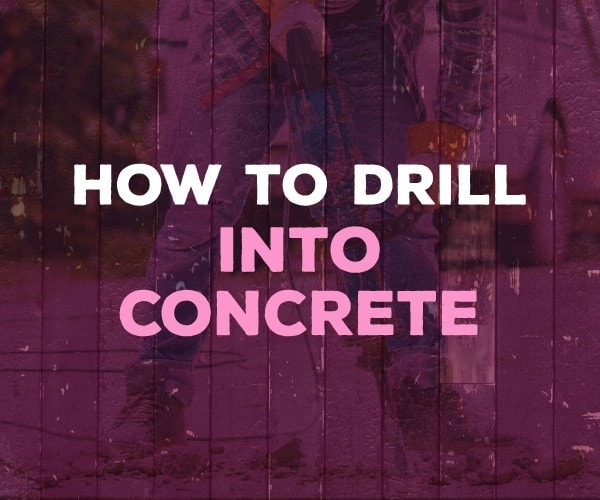Concrete is one of the most versatile and useful building supplies on the planet. But, it can also be one of the most difficult to work with. With it’s cold, hard exterior, it’s easy to see how the average home handyman may get intimidated by the prospect of learning how to drill into concrete.
Fortunately, drilling into concrete isn’t as hard as it looks, and the tips you’ll find in this guide will put you on the right path to drilling concrete for your next project. So, whether you’re mounting a piece of art or television on an interior wall, setting a fence post at the edge of the driveway, or virtually anything else, these tips should have you feeling confident to tackle your next project.
What You’ll Need
Fortunately, there aren’t too many tools you’ll need for this project. Modern concrete is a bit easier to drill into than older concrete from the mid-20th century or earlier. So, you’ll probably be able to get away with using your regular rotary drill for this project if you’re working on newer concrete.
But, if you’re drilling into older, more difficult to work with concrete, a hammer drill will be necessary. When it comes to how to drill into concrete, here’s what you’ll need:
- Rotary drill or hammer drill
- Tungsten carbide masonry bits
- Masonry nail
- Hammer
- Carpenter’s pencil
- Safety goggles
- Work gloves
- Shop vac
Step I: Preparing to Drill
First, you’ll need to mark exactly where you’re going to be drilling. Depending on the project you’re working on this may be as simple as marking the area with your pencil.
But, if you’re drilling multiple holes for a project like mounting a television, you’ll want to reach for a ruler and level during this step to ensure that the positions your marking are perfectly straight and level.
Step II: Making a Guide Hole
Concrete isn’t the easiest surface to work with, and the drill will tend to walk as you start your hole, which can damage the surface of the concrete and ruin the polished look of your project.
To prevent this from happening, we’re going to drill a pilot hole.
Before you begin, make sure to put on appropriate safety gear. Grab your drill and stand with your feet shoulder width apart. Some drills have a handle for your free hand that provides additional control. If your drill has one, make sure to use it to provide extra control. If not, place your free hand on the back of the drill for more control.
If your drill has multiple speeds, go with the slowest speed you have when drilling the guide hole. If not, you’ll want to use a few short bursts to start your guide hole.
It’s critical that you make sure you’re in total control so you can ensure that the drill doesn’t skip across your surface. Once you’ve reached a depth of around ⅛-¼” your guide hole is complete.
Step III: Drilling the Hole
With your guide hole in place, it will now be much easier for you to control the drill as you finish the hole.
If your drill has a stop bar, now would be a good time to set it to the proper depth. If you don’t, take a small piece of tape and wrap it around your drill bit at the appropriate depth, so you can ensure you won’t drill further into the concrete than you need to.
Now, position yourself in front of the hole you’ll be drilling with your feet firmly planted shoulder-width apart. If your drill is variable speed, turn it on high. Press the drill’s trigger and begin to drill further into the surface of the concrete. Apply light pressure to the drill as it makes its way through the concrete.
When working with concrete, keep in mind that you’re likely going to hit pockets of air, or areas where the material is less dense. These areas can make it more difficult for you to control the drill. The best way to approach these areas is to be vigilant and ready for anything as you work.
You also may end up hitting areas of greater resistance as you drill, and it’s important that if you hit one of these passages you stop drilling, instead of trying to force the drill through.
If you hit one of these areas, remove the drill and insert your masonry nail into the hole. Give the nail a few healthy taps with your hammer. This should break up any obstructions in the concrete so you can go back to drilling.
When you resume drilling, drill slowly until you’re sure you’ve passed the obstruction. Once you’ve reached the appropriate depth, your hole is complete, and you can remove the drill.
Step IV: Cleaning Up
With your hole complete, you’ll want to use a shop vac to clean the hole up and remove any chipped concrete or concrete dust from inside the hole. A can of compressed air does the trick as well if you don’t have a shop vac handy. With the hole clean, you’re now ready to install fasteners.
Wrapping It Up
Learning how to drill into concrete can be a harrowing task for the uninitiated. Fortunately, with just a few tools and the tips in this guide, you can be a concrete drilling pro in no time. Be sure to work slowly and safely and in just a few short minutes, your hole will be drilled, and you’ll be ready to get on with your project.

